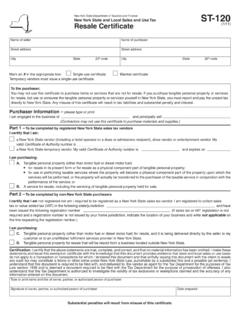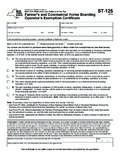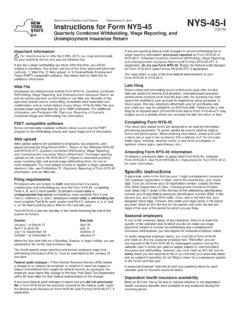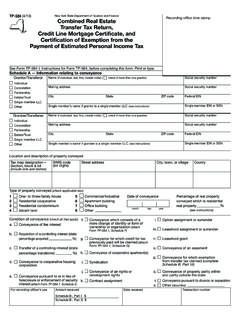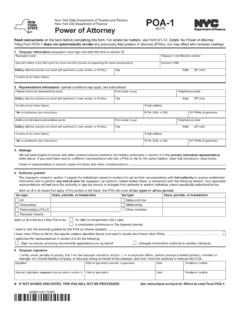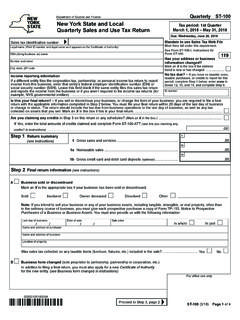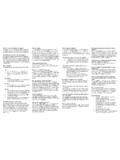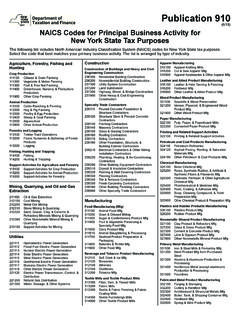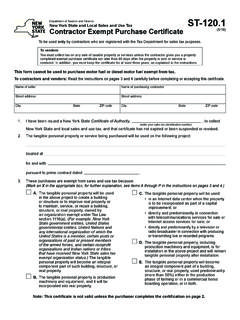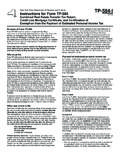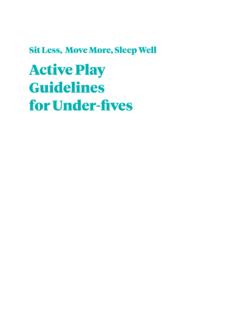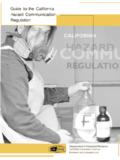Transcription of The Property Tax Cap
1 Publication 1000 (10-11). The Property Tax Cap guidelines for Implementation The information presented is current as of this publication's revision date. Published by the New York State Department of Taxation and Finance and the New York State Department of State Publication 1000 (10/11). Table of Contents Key Components of the Tax Cap .. 1. Technical Information .. 2. I. Applicability .. 2. II. Quantity Change .. 3. III. Inflationary Factor .. 4. IV. Calculating the Tax Levy 4. V. Filing the Levy Limit Calculation .. 5. VI. Limited 6. VII. Erroneous Levies .. 9. VIII. Overrides of the Tax Levy Limit .. 9. IX. Budget Process: Final Adoption of a Budget .. 11. X. Special Circumstances: Consolidation, Dissolution & Transfer of Functions .. 11. XI. Treatment of Chargebacks by Counties 12. Appendix A .. i Appendix B ..ii Appendix C .. iii Appendix D ..iv 2. Publication 1000 (10/11). On June 24, 2011 the Property tax cap was signed into law (see Chapter 97 of the NYS.)
2 Laws of 2011). Below is guidance to assist local governments in the implementation of the Property tax cap. Key Components of the Tax Cap What is the Property tax cap? The tax cap law establishes a limit on the annual growth of Property taxes levied by local governments and school districts to two percent or the rate of inflation, whichever is less. Who is subject to the tax cap? The cap applies to all independent school districts outside of the Big Five Cities ( dependent school districts) and to all local governments including counties, cities, towns, villages and special districts (except those special districts noted below). The cap does not apply to New York City. Are there exceptions to the tax cap? There are limited, narrow exclusions to the cap, including certain costs of significant judgments arising out of tort actions and unusually large year-to-year increases in pension contribution rates.
3 Is there an override mechanism to the tax cap? The tax levy cannot exceed the cap unless 60 percent of voters (for school districts) or 60 percent of the total voting power of the governing body (for local governments) approve such increase. When is the tax cap effective? The cap first applies to local fiscal years beginning in 2012. Local budgets that commenced in 2011 but conclude in 2012 are not affected. 1. Publication 1000 (10/11). Technical Information I. Applicability The tax cap applies to all independent school districts and all local governments outside of New York City, and is intended to capture the broad range of Property taxes levied in New York. Accordingly, the tax cap applies broadly to Property taxes that support all local governments, including special districts that are independently governed as well as special districts that are established, governed and administered by another municipality.
4 Where a local government, such as certain special districts, is wholly integrated within another local government the special district is established, administered and governed by the board of that other local government, and is supported by a tax levy imposed by and under the authority of that other local government then any Property tax being levied by the overarching local government to support the operations of the subordinate special district is considered part of the tax levy of the overarching local government for purposes of administering the tax cap and override vote, if any. The following entities are covered by the cap: All Counties (except those within NYC). All Cities (except NYC). All Towns All Villages All Fire Districts School Districts (including common, union free, central, central high school, and city school districts, but excluding NYC and the Big Four1). Special Districts (including, but not limited to sewer, water, library and fire protection districts).
5 In the case of special districts the tax cap applies as follows: The tax levy of a special district (such as a water or sewer district) that (i). has a separate independent elected board, and (ii) has the authority to levy a tax, or can require a municipality to levy a tax on its behalf, is subject to the tax levy limit. The tax levy of a special district that (i) has a separate independent board appointed by the governing body of another local government, and (ii) has 1. The budgets for the school districts in the Big Four Cities are within the cities' budgets, and those school districts have no separate taxing authority. The portion of the tax cap law applicable to local governments applies to the budgets of the Big Four Cities. 2. Publication 1000 (10/11). the authority to levy a tax, or can require a municipality to levy a tax on its behalf, is subject to the tax levy limit. o To the extent the budget of a special district, such as a library district, is comprised of revenues generated by its own taxing authority, or by a tax levy of another local government that the local government is required to impose on behalf of that special district, those tax revenues fall within the tax levy limit of the special district.
6 To the extent the budget of that special district is comprised of revenues generated by the taxing authority of another local government (such as a town or village), and that local government is not required to impose that tax levy on behalf of the special district, those tax revenues fall within the tax levy limit of the town or village. A tax levy that supports the operations of a special district that is established, administered and governed by the governing body of another local government such as a tax levy imposed by a town or county board, under its authority, to support an improvement district created, administered and governed by that town or county board - is part of that town or county's tax levy, and is to be applied to the tax levy limit of that town or county it is not to be separately reported by the special district. A special district that raises revenue solely through fees based on use is not subject to the tax levy limit.
7 II. Quantity Change The Quantity Change Factor adjusts the tax levy limit to reflect an increase in the full value of taxable real Property in a local government due to physical or quantity change . new growth or significant additions to existing properties. The Commissioner of Taxation and Finance will issue a Quantity Change Factor for all local governments that have experienced an increase in the full value of taxable real Property due to a physical or quantity change. Increases in full value due to changes in assessment only do not constitute a basis for a quantity change factor. A physical or quantity change does not result from the splitting or merging of parcels. Property returning to the tax rolls after the expiration of a PILOT does not constitute a basis for a Quantity Change Factor. 3. Publication 1000 (10/11). III. Inflationary Factor The growth in annual levy is limited to the lesser of 2 percent or the Consumer Price Index (CPI), subject to certain limited exceptions and adjustments.
8 For the purposes of the cap the applicable CPI will be the unadjusted All Items Consumer Price Index for All Urban Consumers (CPI-U), the broadest and most comprehensive measure released by the Bureau of Labor Statistics. The CPI-U is released on a monthly basis, generally in the third week of the subsequent month. Based on the most recently released calendar of release dates, the following table illustrates when the inflationary factor will be available for use by local governments in preparing their levy limit for upcoming budgets. Chart 1. Timing of the Release of CPI-U Index for the Property Tax Cap Inflation Factor Fiscal Year beginning CPI-U period ends CPI-U released January 1, 2012 June 30, 2011 July 15, 2011. April 1, 2012 September 30, 2011 October 19, 2011. June 1, 2012 November 30, 2011 December 15, 2011. July 1, 2012 December 31, 2011 January 14, 2012. IV. Calculating the Tax Levy Limit Each local government shall calculate the tax levy limit for the coming year as follows: First, determine the total amount of taxes levied, not collected, in the prior fiscal year.
9 Property taxes levied by a town to fund the town budget under its taxing authority fall within the town's tax levy limit. Property taxes levied by a town on behalf of another local government ( fire district) pursuant to the taxing authority of that other local government fall within that other local government's tax levy limit. Second, if a "tax base growth factor" has been reported to the local government by the Commissioner of Tax and Finance, the total amount of taxes levied for the prior year is to be multiplied by the growth factor. Third, add any PILOTs that were receivable in the base year. The total amount of PILOTs receivable is to be included in the calculation of the tax levy limit. No adjustment is permitted. 4. Publication 1000 (10/11). Fourth, beginning for fiscal year 2013, subtract the tax levy necessary to support expenditures for tort actions for any amount that exceeds 5 percent of the local government's tax levy in the prior fiscal year.
10 There is no subtraction for these expenditures in the calculation for the 2012 fiscal year. Fifth, multiply the result by the allowable levy growth factor, which will be provided by the Office of the State Comptroller. Sixth, subtract any PILOTs receivable in the coming year. The total amount of PILOTs receivable is to be included in the calculation of the tax levy limit. No adjustment is permitted. Seventh, beginning with fiscal year 2013 budgets, add any available carryover from the prior fiscal year. There is no available carryover for the 2012 fiscal year. Eighth, unused exclusions associated with growth in pension costs or tort judgments may not be carried forward. V. Filing the Levy Limit Calculation Each local government shall submit to the Office of the State Comptroller any information necessary for calculating the tax levy limit for the coming fiscal year prior to adopting a budget for that year.
